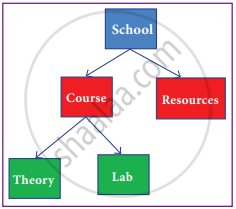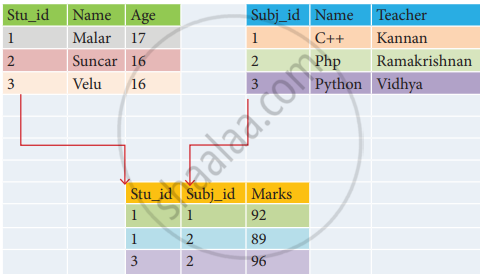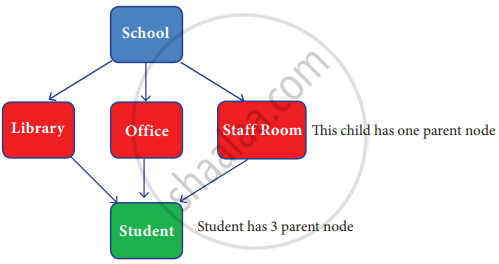Advertisements
Advertisements
प्रश्न
Explain the different types of data models.
उत्तर
The different types of a Data Model are:
- Hierarchical Model,
- Relational Model,
- Network Database Model,
- Entity-Relationship Model,
- Object Model.
Hierarchical Model:
- The hierarchical model was developed by IBM as Information Management System.
- In the Hierarchical model, data is represented as a simple tree-like structure form.
- This model represents a one-to-many relationship i.e., parent-child relationship.
- One child can have only one parent but one parent can have many children.
- This model is mainly used in IBM Main Frame computers.

Hierarchical Model
Relational Model:
- The Relational Database model was first proposed by E.F. Codd in 1970.
- Nowadays, it is the most widespread data model used for database applications around the world.
- The basic structure of data in the relational model is tabling (relations).
- All the information related to a particular type is stored in rows of that table.
- Hence tables are also known as relations in a relational model.
- A relation key is an attribute that uniquely identifies a particular tuple (row in a relation (table)).

Relational Model
Network Model:
A network database model is an extended form of the hierarchical data model. The difference between hierarchical and Network data models is:
- In a hierarchical model, a child record has only one parent node,
- In a Network model, a child may have many parent nodes.
- It represents the data in many-to-many relationships.
- This model is easier and faster to access the data.
Example:
- The school represents the parent node
- Library, Office, and Staffroom is a child to school (parent node)
- The student is a child in the library, office, and staff room (one to many relationships).

Network Model
Entity-Relationship Model. (ER model):
- In this database model, relationships are created by dividing the object into the entity and its characteristics into attributes.
- It was developed by Chen in 1976.
- This model is useful in developing a conceptual design for the database.
- It is very simple and easy to design a logical view of data.
- The developer can easily understand the system by looking at ER model constructed.
- The rectangle represents the entities.
Example. Doctor and Patient.
- Ellipse represents the attributes
E.g. D-id, D-name, P-id, P-name. - Attributes describe the characteristics and each entity becomes a major part of the data stored in the database.
- The diamond represents the relationship in ER diagrams e.g; Doctor diagnosis the Patient

ER model
Object Model:
- Object model stores the data in the form of objects, attributes, and methods, classes, and Inheritance.
- This model handles more complex applications, such as Geographic Information System (GIS), scientific experiments, engineering design, and manufacturing.
- It is used in the File Management System.
- It represents real-world objects, attributes, and behaviours.
- It provides a clear modular structure. It is easy to maintain and modify the existing code.

Object Model
An example of the Object model is Shape,
Circle, Rectangle, and Triangle are all objects in this model
- The circle has the attribute radius.
- Rectangle has the length and breadth of the attribute.
- Triangle has the attributes base and height.
- The objects Circle, Rectangle, and Triangle inherit from the object Shape.
APPEARS IN
संबंधित प्रश्न
What do you understand by Data Model?
Which database model represents the parent-child relationship?
The relational database model was first proposed by ______
What type of relationship does the hierarchical model represent?
Who is called the Father of Relational Database from the following?
Who developed ER model?
What is the difference between the Hierarchical and Network data models?
Explain Object Model with example.
Write a note on different types of DBMS users.
